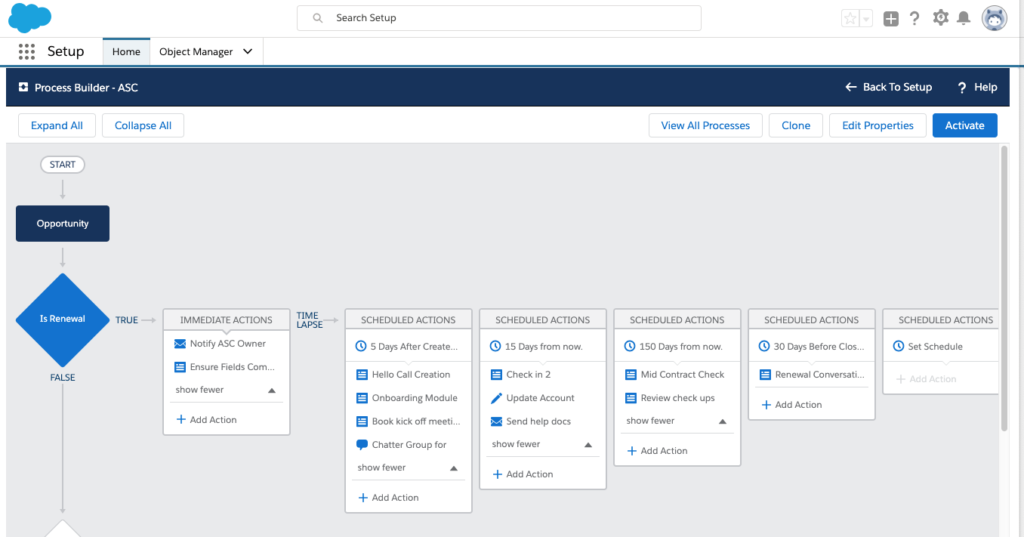Customer Success in Salesforce
Whether you call it Account Management, Retention Teams or Customer Success the truth is that after sale care (ASC) is of massive importance to a business.
At Nebula we come across many different ways in which companies control this process that can vary to a large extent. Here are some of the ways I have seen companies doing this:
- A link sent to another team in an email
- An Opportunity can only be Closed Won once hand-over information has been completed. The closure triggers the creation of a new Opportunity who’s close date is specified from the length of the subscription
- The Customer Success Director looks at a report of closed Opportunities and hands them out
- Salesforce CPQ is utilised to control the Contracts and Subscriptions for each customer. Specific teams must complete specified tasks at various points during the contract. A Pardot campaign is also used to ensure the correct interactions. It works dynamically depending on the severity of Open Cases.
Basically this needs to fit with your company needs and requirements. So where do you start? I start by going through the following 7 questions and evaluating them in depth to help companies design and build a lasting solution.
Do you have any statistics on churn rates and contact levels at present?
If you do have the statistics they can be invaluable for finding pressure points which need to be addressed. If you don’t then I would advise using your current information, be it stored in data or in people’s heads, to establish the following:
- At what point do people tend to end their subscription?
- Do your customers have any patterns of behaviour before ending their use of your product? Such as reduced/increased usage, Logging Tickets or making comments on social media
- What is the process for customers ending their subscription with you? Do they follow it or just stop paying?
- For customers who don’t end their business with you, how often do you contact them? And when do you contact them in relation to the Close Date?
- Are there any particular industry verticals that tend to leave/stay?
Getting this information together can give you a good idea of who will stay, who will go and, most importantly, what you can do to control this flow. At the end of the day phoning people hundreds of times who are likely to leave anyway is a waste of resources.
When do your ASC team first contact your customers?
Salesforce has a lot of very powerful mechanisms for helping automate workflow for your ASC team. These can be used to personalise and standardise your process to ensure that you are interacting with your customers exactly how they want to be interacted with. This is an example of the type of workflow we often build in Process Builder:

It is worth noting that this type of process should be considered a starting point. If, for instance, you currently don’t have a standard approach then getting something in place will allow you to find out how your customers like to be interacted with. You can then alter this process without needing any coding help.
Do you currently have the concept of a watch list for your accounts?
If you don’t use a Client Watch system at present then this is worth looking at. The general idea is that it gives you a classification of the health of your accounts which can be displayed in reports and in a page component, often with a traffic light style of display. The way you determine what should be on which watch status will be specific to your company and product, but the frequently used metrics include:
- Missed Payments
- Change in use levels
- A high number of support tickets logged
- Reviews given (positive actions count as well)
- CSAT scores
- Main contacts leaving
How does your hand over process work from Sales to ASC?
When determining the process for ASC it is a great time to ensure that they have all the information they need. This could mean automatically creating tasks for meetings with the original sales person or simply ensuring that there is a link on a renewal back to the original Opportunity. I often find this is frequently overlooked so is built out in the company process.
Does ASC only take place if the customer raises a ticket?
It is not unusual, especially in companies without a subscription model, that ASC only takes place if a customer raises a ticket. In this case you will not need to create specific follow up calls or tracking information, but it would be very helpful to ensure that you can see all the information easily and quickly on the Case record. It is also very helpful to track multi-purchases and engagement levels on tickets. Following on from the first point, having the right Dynamic Lists in your marketing system can give you an easy link into marketing to them well.
What reports would you like to have from ASC?
Again this is very personal but definitely worth evaluating as part of the process. I often find the key reports tend to include:
- Customers on Red/Amber
- Often broken down by Owner and shown in a Dashboard on their home page
- A secondary version of this breaks the customers down by industry vertical
- A third version of this shows the amount of revenue at risk
- Customers without contact for X amount of time
- Customers with a high number of tickets created in the last month
- Upcoming renewals
- Upcoming renewals on Red/Amber
You will no doubt find that when you speak with your ASC team they will have specific metrics that are helpful to them. When you delve into the reason for this you are very likely to find key renewal indicators.
Do you currently use Service Cloud and/or Salesforce CPQ?
There are a lot of tools that are available through Salesforce or are part of it already. Two examples are Service Cloud and CPQ. Service Cloud gives you very good control over you ticketing system. It can even bring in elements such as SOS which enable you to have immediate video calls within your apps and websites with customers in trouble. Salesforce CPQ gives you a very thorough mechanism for handling complicated pricing and subscriptions as well as dynamic payment schedules. As both of these systems sit inside Salesforce they are easily brought into reports and on the whole can be configured by System Admins without the need for code. Third party systems can also be installed within Salesforce to provide you with custom functionality, however most companies can create a very strong solution without the need to use them.
Once you have been through these points and pulled together the information, you should be in a good position to start implementing an ASC system within Salesforce for your Company. Don’t forget though that this is not a one time implementation. It will need to be kept up to date to make the most of shifting interactions with customers and changes within your company.
If you need any help with this, don’t hesitate to contact us.
